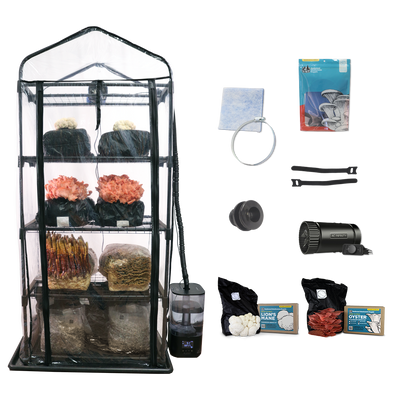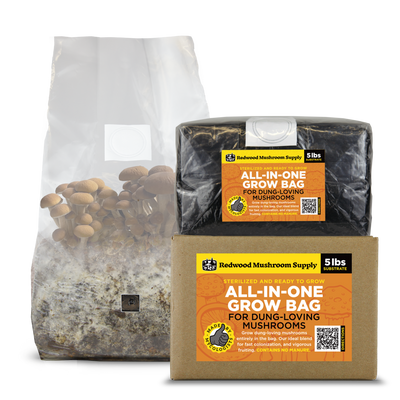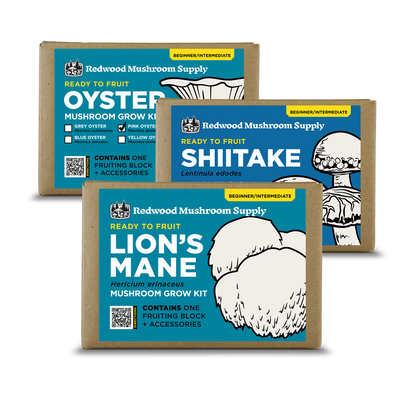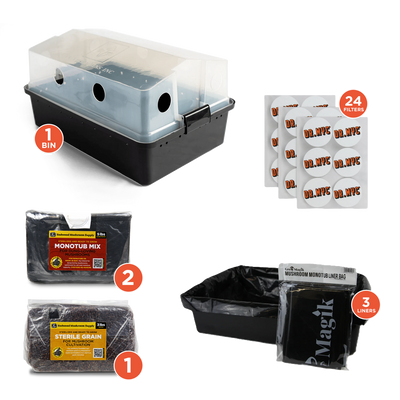Inoculation is the process of introducing a fungal culture into a new growth medium. It is essentially the “planting” of mycelium onto a new food source.
There are two primary components of the inoculation process;
- Inoculum: This is the source of your fungal culture. For most folks simply interested in growing mushrooms, you will be utilizing mushroom spawn as an inoculum. If you wish to produce spawn or maintain cultures, you might use other inoculums such as agar, liquid cultures, spores, or fresh tissues from a fruiting body.
- Growth Media or Substrate: This is the new food source into which you are introducing the fungi. For example, pasteurized/sterilized sawdust or straw is the most commonly utilized substrate as a final growth medium. Grain or sawdust are the growth substrates used for the production of spawn, while agar or liquid culture solutions are utilized for the maintenance/production of cultures.
Below is a table with some information about different types of inoculum and their suitable growth media/substrates. If you are only interested in growing mushrooms and not conducting any laboratory work, don’t worry too much about understanding the table.
| Inoculum | Description | Can Inoculate |
|---|---|---|
| Spores | Spores are the reproductive cells of a fungus and are typically only recommended for inoculating agar. Since they are usually collected in non-sterile conditions, they require further isolation until a clean culture is obtained. In some cases, spores can be utilized to inoculate spawn, but this method is prone to contamination. |
|
| Fruiting Body | Fruiting bodies can be cloned into agar, but since they often contain contaminants, they require further isolations for a clean culture to be obtained. |
|
| Agar | Agar is the growth medium typically utilized in petri dishes to keep or isolate fungal cultures. A clean culture in agar can be used to inoculate almost any growth medium. However, it is not recommended for inoculating bulk substrates as it will be slow and lack vigor compared to grain spawn. |
|
| Liquid Culture | Liquid Cultures are as the name suggests. A culture of fungal mycelium cultivated in a liquid growth medium. It is typically utilized for inoculating spawn, although they can be expanded onto more liquid culture solutions or agar. It is not recommended for bulk substrate as it may grow slowly and lack vigor. |
|
| Spawn | Spawn is typically utilized to inoculate a bulk substrate. It can also be expanded onto grains or sawdust to multiply existing spawn. If necessary, it can also be used to inoculate agar. |
|
| Bulk Substrate | Bulk Substrate is not recommended as an inoculum as it usually lacks sterility and vigor when compared to spawn. This being said, some enthusiasts get away with using a colonized grow kit to inoculate more bulk substrate. In this case, it is ideal to use the grow kit before fruiting. It’s also fair game to isolate a culture from bulk substrate onto agar. |
|
The Two Types Of Inoculation

One of the biggest misconceptions about mushroom cultivation is that you need a rigorously controlled laboratory-like setting. While a clean, sterile environment is mandatory for certain processes, the truth is mushroom cultivation can be done anywhere, if done correctly. Certain forms of inoculation can even be done outdoors.
-
Non-Sterile Inoculation: This form of inoculation can be done outside, in your kitchen, or in just about any environment.
-
Unsupplemented substrates (pure sawdust or straw) can be inoculated with spawn in non-sterile environments.
-
Liquid culture syringes can be used to inoculate sterilized grains or other liquid cultures in almost any environment.
-
Inoculating logs is inherently non-sterile and can be done anywhere.
-
Sterile and Aseptic Inoculation: For the production of agar, liquid cultures, or spawn, it is recommended to work in sterile conditions using an aseptic technique. This is also true when inoculating supplemented bulk substrates.
-
Sterile conditions are typically provided by a laminar flow hood or a still airbox.
-
Aseptic technique is the careful process mycologists use to ensure they do not introduce contaminants into their growth media.
The Need (or lack thereof) for Sterile Inoculation
Spores, bacteria, and yeasts are omnipresent in our environment. They’re in the air we breathe, they’re on our bodies, and present on almost every surface imaginable. Reducing the risk of contamination from these microorganisms is a crucial part of mushroom cultivation.
While in some cases there is a risk of introducing harmful microorganisms during inoculation, this is not always the case. When it comes to low-nutrient pasteurized substrates, introducing contamination during inoculation is actually a relatively low risk. It is recommended to do this as cleanly as possible, but inoculations can be done in open-air or even outdoor environments.
This is because low-nutrient substrates (such as straw or unsupplemented sawdust) do not allow for the proliferation of harmful microorganisms, which allows your selected species to outcompete and dominate the growth substrate. Pasteurized substrates also keep an active population of beneficial or benevolent bacterias which help deter the growth of harmful microorganisms.
On the other hand, the inoculation of spawn, agar, liquid cultures, or supplemented substrates requires sterile and aseptic inoculation. These substrates/growth media are very prone to contamination.
Inoculation Rates

The inoculation rate simply refers to the quantity of inoculum utilized to inoculate a growth medium. Typically speaking, this refers to the percentage of spawn used to inoculate a bulk substrate, although it is applicable to other processes.
Generally speaking, a higher inoculation rate means faster colonization, reduced risk of contamination, and even larger yields. The downside is that inoculum (such as spawn) is often a limited resource with relatively high economic costs.
Factors That Can Influence Your Inoculation Rate
-
Contamination Risk: The higher the risk of contamination, the greater your inoculation rate should be. For example, if you have perfect sterile conditions and are working with a well-sterilized substrate, very low inoculation rates are suitable. This same substrate under less-than-ideal conditions should be boosted with a higher inoculation rate.
-
Spawn Vigor: If you have a very fresh and vigorous spawn, you can utilize a lower inoculation rate. Sawdust spawn also tends to be less vigorous, requiring a higher inoculation rate.
- Species: Vigorous species like oyster mushrooms require lower inoculation rates as they can quickly colonize a substrate and prevent contamination.
Generally speaking, inoculation rates for bulk substrate range from 1:50 (2%) to 1:10 (10%) spawn-to-substrate ratio. A 1:50 (2%) ratio can be suitable for those conducting sterile and aseptic inoculation. Non-sterile inoculation should utilize at least 1:20 (5%). When employing a liquid culture syringe for inoculating sterilized grains (for spawn), you typically want to use about 1-2 ml per lb of grain.
Non-Sterile Inoculation
This form of inoculation is the most suitable for beginners who simply want to grow mushrooms and don’t want to bother with the delicate process of the aseptic technique. It is primarily helpful for the inoculation of bulk substrates and logs but is also valid for inoculation with liquid culture syringes.
Inoculating Unsupplemented and Pasteurized Substrates

The most common unsupplemented substrates are simply sawdust and straw. These are relatively low in nutrients and pose a low contamination risk. This is in contrast to supplemented substrates, which contain additional bran, soybean hull, or other additives that result in higher yields but have a higher contamination risk.
Unsupplemented substrates are typically only pasteurized, meaning they retain some of the beneficial microbes that ward off contamination. While unsupplemented substrates have a lower yield, the most significant benefit is that they do not require strict sterilization or sterile conditions for inoculation.
Unsupplemented substrates can be inoculated outdoors, on your kitchen counter, or almost any environment!
How to Inoculate Mushroom Substrate
The basic concept of inoculating a bulk-substrate is to combine your mushroom spawn and your substrate. There are various methods for doing this.
-
Lasagna Method: This entails filling your grow kit with alternating layers of substrate and spawn.
-
Thoroughly Mixed Method: This pretty much means thoroughly mixing your substrate with your spawn before filling your grow chamber or grow bag. This can either be done in a sanitized tote or container, or a large clean and disinfected surface.
-
Mixing in Bag: Adding a small amount of grain to a bulk substrate and then resealing and shaking bag to distribute the spawn (Expand on this or write in your own style)
Tips For Inoculating Unsupplemented and Pasteurized Substrates
- Basic cleanliness and disinfection should still be used. This means wearing clean clothes and washing your hands/arms thoroughly. Disinfection of hands, surfaces and any materials with 70% Isopropyl alcohol is also recommended. Gloves can be used but are not required.
- Having a clean and disinfected workspace is recommended when inoculating a bulk substrate. This could simply be a table or any surface that can be easily washed. This helps you recover and spawn or substrates that might be spilled during the inoculation.
- Avoid touching spawn with your bare hands. Either use gloves or simply pour directly from the container your spawn is in. This avoids exposing the fresh mycelium to any additional contamination early in its growth phase.
Liquid Cultures As a Self-Contained Lab

Liquid cultures can be an amazing asset to amateur growers who do not have access to laboratory conditions and don’t want to bother with a still-air box. By utilizing a syringe to transfer a liquid culture into new growth mediums, your culture never has to be exposed to the external environment!
This means you can inoculate sterilized grains or sawdust for spawn, or expand your liquid culture solution almost anywhere. Liquid cultures can be inoculated via a syringe through a specialized injection port or right through a plastic grow bag. In the latter case, cover the inoculation point with tape after injection.
When inoculating liquid culture, it is still good to take basic measures to prevent contamination. Disinfect your injection site with 70% Isopropyl alcohol and sterilize the syringe needle with a lighter or alcohol lamp until it is glowing. Once cooled down, you can go ahead and inject.
For spawn, it is typically recommended to inoculate at a rate of 1-2 ml per lb of material. When expanding liquid culture, you only need 1-2 ml of liquid culture per liter. While it is possible, it is not recommended to inoculate bulk substrates with liquid culture. This is because inoculating with liquid culture into bulk substrates can be very slow.
Sterile and Aseptic Inoculation
Sterile and Aseptic Inoculation is necessary for the inoculation of supplemented substrates, spawn, agar, and liquid cultures It is considered a more advanced and requires the use of a laminar flow hood or still air box. While it is not typically recommended for beginners, we encourage anyone with the resources and curiosity to give it a shot!
| Sterile and Aseptic Inoculation | |
|---|---|
| Pros | Cons |
|
|
Inoculating Supplemented Bulk Substrates

Like previously mentioned, supplement substrates (such as Masters Mix) are sensitive to contamination and require thorough sterilization. They must be sterilized in their grow bag/container to prevent excessive exposure to the environment, and inoculated in front of a flow hood or in a SAB.
The easiest way to do this is to leave enough room in your grow bag so that well broken-up spawn can be poured on top of the substrate. After this, the grow bag is closed (with impulse sealer or clip) and shaken to distribute the spawn evenly.
Alternatively, if your grow bag is full, you can top-spawn the bag and let the mycelium grow downwards into the substrate. This process is significantly slower.
Agar, Liquid Culture, and Spawn
Producing agar, liquid cultures, and spawn is often considered a more advanced process most relevant for experienced cultivators. These procedures are a world of their own and will be discussed in a future article!
Conclusion
Inoculation is a basic concept that comes in many forms. In some cases, it can be done anywhere, while in others, it requires certain protocols to ensure sterility. We hope to have more content soon, which can provide deep dives into more specific parts of the inoculation process. Stay tuned, and happy growing!




